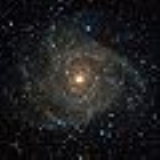
IC 342
Encyclopedia
IC 342 is an intermediate spiral galaxy
in the constellation
Camelopardalis
. The galaxy is located near the galactic equator where dust obscuration makes it a difficult object for both amateur and professional astronomers to observe.
IC 342 is one of the brightest two galaxies in the IC 342/Maffei Group of galaxies, one of the galaxy groups that is closest to the Local Group
. The galaxy was discovered by William Frederick Denning
in 1895. Edwin Hubble
first thought it to be in the Local Group
, but later it was demonstrated that the galaxy is outside the Local Group.
In 1935, Harlow Shapely declared that this galaxy was the third largest galaxy by angular size then known, smaller only than the Andromeda Galaxy
(M31) and the Triangulum Galaxy
(M33), being wider that the full moon
. This does not take into account the visual size of the LMC
or SMC
.
It has a H II nucleus.
Intermediate spiral galaxy
An intermediate spiral galaxy is a galaxy that is in between the classifications of a barred spiral galaxy and an unbarred spiral galaxy. It is designated as SAB in the galaxy morphological classification scheme.-Grades:...
in the constellation
Constellation
In modern astronomy, a constellation is an internationally defined area of the celestial sphere. These areas are grouped around asterisms, patterns formed by prominent stars within apparent proximity to one another on Earth's night sky....
Camelopardalis
Camelopardalis
Camelopardalis is a large but faint constellation in the northern sky. The constellation was introduced in 1612 by Petrus Plancius. Some older astronomy books give an alternative spelling of the name, Camelopardus.-Etymology:...
. The galaxy is located near the galactic equator where dust obscuration makes it a difficult object for both amateur and professional astronomers to observe.
IC 342 is one of the brightest two galaxies in the IC 342/Maffei Group of galaxies, one of the galaxy groups that is closest to the Local Group
Local Group
The Local Group is the group of galaxies that includes Earth's galaxy, the Milky Way. The group comprises more than 30 galaxies , with its gravitational center located somewhere between the Milky Way and the Andromeda Galaxy...
. The galaxy was discovered by William Frederick Denning
William Frederick Denning
William Frederick Denning was a British astronomer.Denning devoted a great deal of time to searching for comets, and discovered several including the periodic comet 72P/Denning-Fujikawa and the lost comet D/1894 F1...
in 1895. Edwin Hubble
Edwin Hubble
Edwin Powell Hubble was an American astronomer who profoundly changed the understanding of the universe by confirming the existence of galaxies other than the Milky Way - our own galaxy...
first thought it to be in the Local Group
Local Group
The Local Group is the group of galaxies that includes Earth's galaxy, the Milky Way. The group comprises more than 30 galaxies , with its gravitational center located somewhere between the Milky Way and the Andromeda Galaxy...
, but later it was demonstrated that the galaxy is outside the Local Group.
In 1935, Harlow Shapely declared that this galaxy was the third largest galaxy by angular size then known, smaller only than the Andromeda Galaxy
Andromeda Galaxy
The Andromeda Galaxy is a spiral galaxy approximately 2.5 million light-years from Earth in the constellation Andromeda. It is also known as Messier 31, M31, or NGC 224, and is often referred to as the Great Andromeda Nebula in older texts. Andromeda is the nearest spiral galaxy to the...
(M31) and the Triangulum Galaxy
Triangulum Galaxy
The Triangulum Galaxy is a spiral galaxy approximately 3 million light years from Earth in the constellation Triangulum. It is catalogued as Messier 33 or NGC 598, and is sometimes informally referred to as the Pinwheel Galaxy, a nickname it shares with Messier 101...
(M33), being wider that the full moon
Full moon
Full moon lunar phase that occurs when the Moon is on the opposite side of the Earth from the Sun. More precisely, a full moon occurs when the geocentric apparent longitudes of the Sun and Moon differ by 180 degrees; the Moon is then in opposition with the Sun.Lunar eclipses can only occur at...
. This does not take into account the visual size of the LMC
Large Magellanic Cloud
The Large Magellanic Cloud is a nearby irregular galaxy, and is a satellite of the Milky Way. At a distance of slightly less than 50 kiloparsecs , the LMC is the third closest galaxy to the Milky Way, with the Sagittarius Dwarf Spheroidal and Canis Major Dwarf Galaxy lying closer to the center...
or SMC
Small Magellanic Cloud
The Small Magellanic Cloud is a dwarf galaxy. It has a diameter of about 7,000 light-years and contains several hundred million stars. It has a total mass of approximately 7 billion times the mass of our Sun....
.
It has a H II nucleus.
External links
- NASA Astronomy Picture of the Day – 22 December 2010
- IC 342 (image included) at NOAO.eduNational Optical Astronomy ObservatoryThe National Optical Astronomy Observatory is the United States national observatory for ground based nighttime ultraviolet-optical-infrared astronomy. The National Science Foundation funds NOAO to provide forefront astronomical research facilities for US astronomers...
- IC 342 The hidden Galaxy

